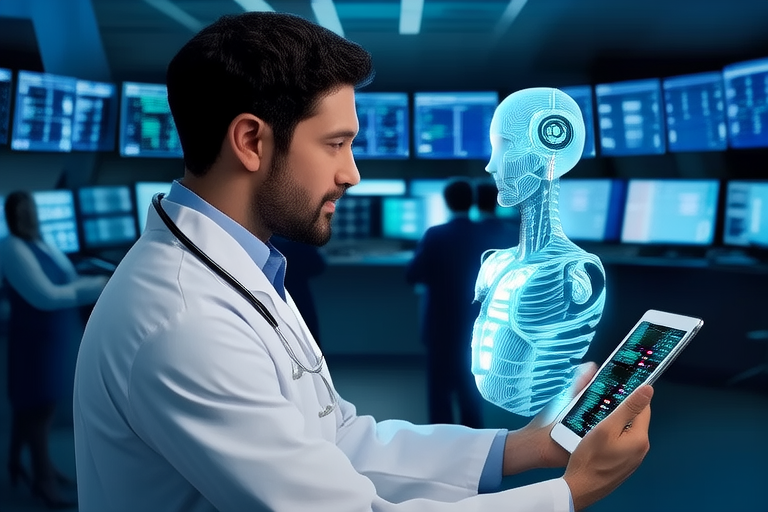From Healthcare to Finance: The Transformative Power of Artificial Intelligence
Introduction
Artificial intelligence (AI) has emerged as a pivotal force in driving innovation and efficiency across various sectors. Defined broadly as the simulation of human intelligence processes by machines, AI encompasses machine learning, natural language processing, and robotics, among other technologies. As AI continues to evolve, it is reshaping industries from healthcare to finance, offering unprecedented opportunities for growth, efficiency, and improved service delivery.
This article explores the transformative power of AI in two critical sectors: healthcare and finance. By examining current applications, potential future developments, and cross-industry impacts, we aim to provide a comprehensive overview of how AI is revolutionizing these fields and what this means for the future.
Section 1: AI in Healthcare
In healthcare, AI is already making significant strides, enhancing diagnostics, personalizing treatments, and improving patient outcomes. Machine learning algorithms, for instance, can analyze vast amounts of medical data to detect diseases at an early stage. These tools not only help in accurate diagnosis but also contribute to more effective treatment plans tailored to individual patients.
One notable application is the use of AI in radiology. For example, deep learning models can analyze X-rays, MRIs, and CT scans to identify abnormalities that might be missed by human eyes. This technology has been particularly useful in detecting conditions such as cancer, cardiovascular diseases, and neurological disorders. Additionally, AI-driven robotic surgeries offer precision and reduced recovery times, further enhancing patient care.
Predictive analytics powered by AI also plays a crucial role in preventing diseases before they manifest. By analyzing genetic data, lifestyle factors, and environmental influences, AI can forecast health risks and suggest preventive measures. This proactive approach not only improves patient outcomes but also reduces overall healthcare costs.
The future of AI in healthcare looks promising, with advancements in genomics expected to unlock new insights into personalized medicine. Telemedicine, supported by AI, will likely become more prevalent, allowing remote consultations and monitoring. These developments promise to make healthcare more accessible and efficient, ultimately leading to better patient care.
Section 2: AI in Finance
In the realm of financial services, AI is transforming operations through enhanced fraud detection, algorithmic trading, and customer service via chatbots. Financial institutions leverage AI to analyze large datasets, identifying patterns and trends that inform risk management and investment strategies.
Fraud detection is one area where AI shines. Machine learning models can quickly sift through transactional data to flag suspicious activities, thereby minimizing losses and protecting customers. Similarly, algorithmic trading relies on AI to execute trades at optimal times, based on market conditions and historical data. This not only increases profitability but also reduces human error.
Customer service has also seen significant improvements with the introduction of AI-powered chatbots. These virtual assistants can handle routine inquiries, provide financial advice, and even assist in complex transactions. By automating these tasks, financial institutions can improve operational efficiency and enhance the customer experience.
However, the integration of AI in finance comes with its own set of challenges. Data privacy and security remain top concerns, especially given the sensitive nature of financial information. Ensuring robust cybersecurity measures is essential to protect against breaches. Additionally, workforce adaptation is crucial as AI replaces certain roles with automated processes. Financial institutions must invest in reskilling employees to take on new responsibilities.
Ethical considerations also play a vital role in the deployment of AI in finance. Transparency in decision-making, fairness in algorithmic outcomes, and accountability for AI-driven actions are key areas that require careful attention. Regulatory bodies must keep pace with technological advancements to ensure compliance and consumer protection.
Section 3: Cross-Industry Impact
While healthcare and finance are distinct industries, they share many similarities in their adoption and application of AI. Both face challenges related to data privacy, security, and workforce adaptation. In healthcare, ensuring the confidentiality of patient records is paramount, just as protecting financial data is critical in finance.
Collaboration between these industries could lead to groundbreaking innovations. For example, AI models developed in healthcare for disease prediction could inspire similar approaches in finance for risk assessment. Conversely, financial institutions’ expertise in data analysis could benefit healthcare in optimizing resource allocation and cost management.
Moreover, the development of cross-industry standards and best practices would facilitate smoother integration of AI technologies. Sharing knowledge and experiences across sectors could accelerate the pace of innovation and drive broader societal benefits.
Conclusion
In conclusion, AI is undeniably transforming healthcare and finance, offering immense potential for improvement in service delivery, efficiency, and innovation. From diagnosing diseases to managing financial risks, AI is reshaping the way we approach these critical sectors.
As we look to the future, the continued evolution of AI promises even greater advancements. Genomic breakthroughs in healthcare and sophisticated trading algorithms in finance are just the beginning. With careful consideration of ethical, regulatory, and operational challenges, AI will undoubtedly play a central role in shaping the future of these industries and beyond.




